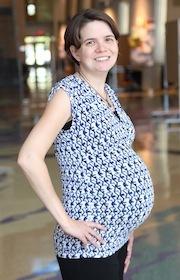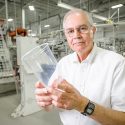With NIH New Innovator Award, engineer to study how ovarian cancer spreads
With approximately 22,000 diagnoses annually in the United States, ovarian cancer isn’t among the most commonly occurring cancers. Yet, the mortality rate for women who have ovarian cancer hovers above 60 percent.
For Pamela Kreeger, a University of Wisconsin–Madison assistant professor of biomedical engineering, that number is needlessly high. Kreeger is among a group of forward-thinking researchers to receive a 2014 New Innovator Award from the National Institutes of Health. And with funding of nearly $2.3 million, she is studying what factors cause ovarian cancer cells to progress from their origin in a woman’s fallopian tube through the ovaries and on to metastatic sites — where they become resistant to chemotherapy drugs.

Pamela Kreeger
“When we look at most cancers, we focus on gene mutations and how they impact the cells’ behavior, and then that’s the drug target,” she says. “Cancer is somewhat clonal, so early mutations tend to replicate throughout the tumor. But some cancers don’t show this clear pattern of mutated genes for clinicians to target.”
That’s the case with ovarian cancer, according to a 2011 study of the disease by The Cancer Genome Atlas (TCGA) Research Network. Nearly all ovarian cancers have a mutation in the gene TP53 — a gene that encodes a tumor suppressor protein that normally prevents cancer development, and is very difficult to target therapeutically.
However, ovarian cancer cells also tend to have increased or decreased copies of genes — rather than mutations in the genes themselves. “So, the proteins are all potentially there and may function in the normal way, but their relative levels are skewed,” says Kreeger. “Ovarian cancer patients have a common mutation and then a proteomic mess.”
As a result of this pattern, Kreeger’s hypothesis is that the genetic mutation is less of a factor in the cancer’s spread than is protein expression, which is the way that proteins are made, regulated and modified in cells. “What the TP53 mutation sets up is the genomic instability where we see changes in the levels of proteins,” she says. “I’m trying to figure out what we can target as a result of this variation.”
“… the disease is nearly universally diagnosed too late — so understanding ovarian cancer’s early stages might lead to new screens for the disease, as well as potential treatments.”
Pamela Kreeger
Kreeger’s research will draw on her background in three seemingly different areas: ovarian cancer biology, biomimetic culture development, and using systems biology models to analyze quantitative data. For this project, she is developing in vitro culture systems to mimic the spread of ovarian cancer cells through a woman’s body, and how they develop resistance to chemotherapy.
Using these models, she and her students will examine how cells with different protein expression patterns will behave, and then, drawing on Kreeger’s expertise in developing computer models, they will simulate how multiple variables impact cell decisions and influence tumor progression. “Progress in treating ovarian cancer over the last 30 years has been flat,” she says. “One reason is that the disease is nearly universally diagnosed too late — so understanding ovarian cancer’s early stages might lead to new screens for the disease, as well as potential treatments.”
Kreeger hopes researchers can use her tools and approach in their efforts to understand progression in other cancer types, because many tumors have both genetic mutations and quantitative protein variations in their cell networks.
Kreeger says there are two other keys to her research: an engineering background, which helps her address a multifaceted biological challenge, and UW–Madison’s culture of transdisciplinary collaboration. “Wisconsin is the kind of environment in which people can take on this high-risk, high-reward research because of the intellectual openness here,” she says. “People talk to each other, and they naturally want to collaborate. They want to see if there’s a way to do it better by working together. It’s just a part of our culture and what makes Wisconsin a fantastic place to do research.”
Subscribe to Wisconsin Ideas
Want more stories of the Wisconsin Idea in action? Sign-up for our monthly e-newsletter highlighting how Badgers are taking their education and research beyond the boundaries of the classroom to improve lives.



